When my brother and I were little kids, my father used to take us for walks along the railroad tracks between his mother’s house and our house. It was the same track, the same woods, the same creek where he played as a kid. We would cross the railroad bridge over Martha Berry Blvd, throw a few rocks into the oily pond in the abandoned rock quarry behind the VW dealer, then usually climb the little hill that the tracks cut through. The cut was just high enough for us to see the tops of the freight cars if a train happened to pass. One winter day we decided to build a fire in a little notch at the top of the cut. It was a cozy little place down out of the wind, with rocks to sit on and a convenient place to build a fire. We gathered dead wood and whatever we could find and had our fire. I don’t remember many details about that day or the days after – it was more than 50 years ago, after all – and that’s probably a good thing, because it means I don’t remember much about the terrible poison ivy rash I got. It was on my face, in my ears, even in my nose, everywhere that the smoke from the fire touched bare skin. I’m lucky it didn’t get into my lungs.
When my brother and I were young, we spent a lot of time every summer itching and scratching and getting calamine lotion dabbed on us. My father, on the other hand, could pull poison ivy plants out of the ground with his bare hands and never get a single blister. I don’t know about my mother, because she never ran like a wild animal through the woods, totally oblivious to whatever green plants we were crashing through. As an adult, I almost never get a poison ivy rash. Maybe a few blisters here and there, but nothing serious.
I was reminded of this a little over two weeks ago when I found some poison ivy in my mother’s yard while we were clearing out 10 years’ worth of overgrowth. I was cutting small shrubs, maple seedlings and a lot of undergrowth in the midst of a lot of ground cover like vinca and ivy. It turned out that there were a few poison ivy plants here and there. I saw some of it, but not all. This is how I know.
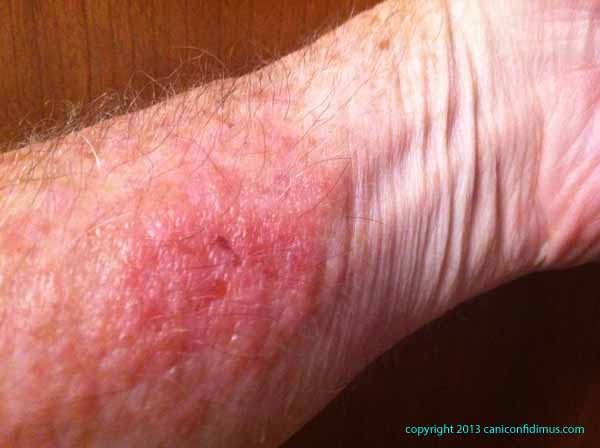
My little rash
This has all the characteristics. It’s itchy. It’s a red, inflamed, itchy mass of blisters. Did I mention that it’s itchy?
I’m not sure why it never occurred to us to look for the plants when we were kids. I guess kids don’t do that sort of thing. Certainly any adult with my experience should have developed a good eye for recognizing poison ivy. It’s obvious now that I’m as sensitive as ever, but usually I’m good at identifying it and avoiding it.
Identification is the important part of avoiding poison ivy. We use the same approach in identifying something like poison ivy that the quality control people use to distinguish between good and bad parts in manufacturing, or that the military would use in identifying an incoming enemy missile. It’s called pattern recognition, or, in the missile defense world, discrimination. We do it all the time. We recognize family or friends at a distance. We can tell a good apple from a bad apple. We recognize an old tortoise friend. We’re so good at it that we can see patterns where there aren’t really any. Like bears in the stars, a goose in a cloud, or Jesus in a piece of toast.
We recognize the patterns by features. In the case of faces, it’s the actual features we recognize. Nose, eyes, mouth, hair. The usual. In the case of a bad apple, it might be a dark spot, or a mushy feel. In the case of poison ivy, the key feature is a set of three leaves: Leaves of three, let it be. That is really a very important feature, and even though there are other plants that have leaf triplets, there is another saying that applies when it comes to poison ivy: Better safe than sorry. With poison ivy, as with incoming nuclear missiles, you really prefer false positives to false negatives.
This is almost all poison ivy, although there is at least one little oak there. This and the following pictures were taken near our house when I took the dogs for a walk. It had rained that day, so the leaves are shinier than usual.
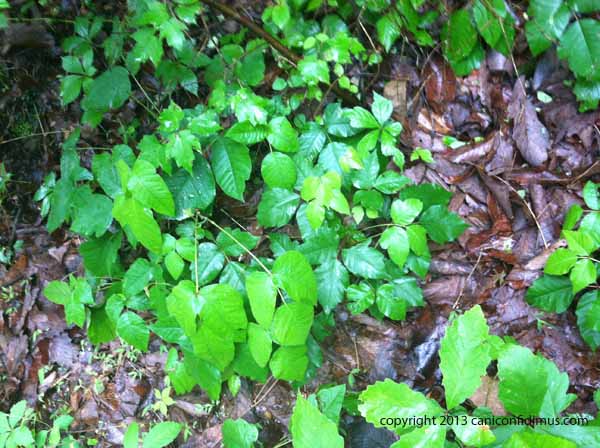
This is a pretty easy test
As I mentioned, there are other plants with three leaves. Kudzu is a good example, and, unfortunately, poison ivy and kudzu are often intermixed. We also find a good bit of muscadine in many of the same places that we find poison ivy.
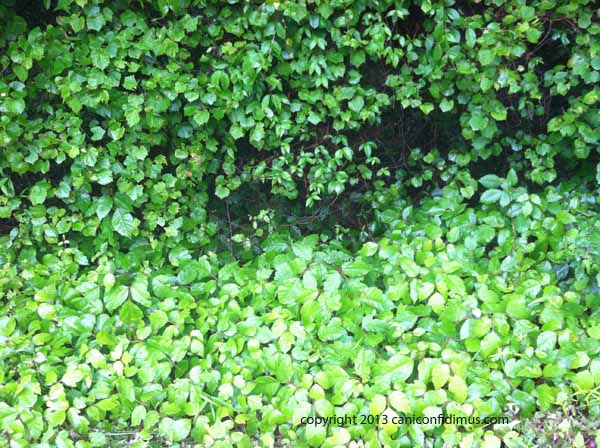
Poison ivy plus some muscadine above
Here is some poison ivy and kudzu. The kudzu is in the right part of the picture. It’s really not easy to tell the difference here, but it is a little easier in person.
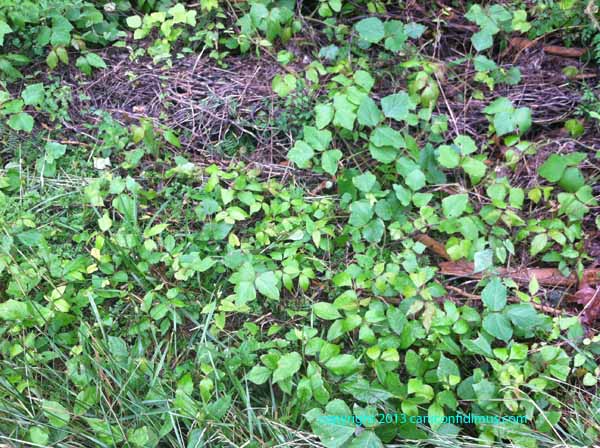
Poison ivy plus kudzu
Kudzu is tricky. It has three leaves, and the leaves themselves resemble poison ivy. Unpleasant experience teaches how to tell the difference. Poison ivy often – but not always – has serrated leaves, and the pattern of veins on the leaves is different from kudzu. It’s fairly easy to mistake kudzu for poison ivy, but it’s almost impossible to mistake poison ivy for kudzu. At least for me.
Blackberries also have leaves of three, and if you verbally described a poison ivy leaf, you might think a blackberry leaf was similar. But they really aren’t very similar.

Blackberries have leaves of three, too
Poison ivy also grows as a vine. Here are two vines. Please excuse the quality of these shots. I had two leashed dogs on one hand and my phone in the other.
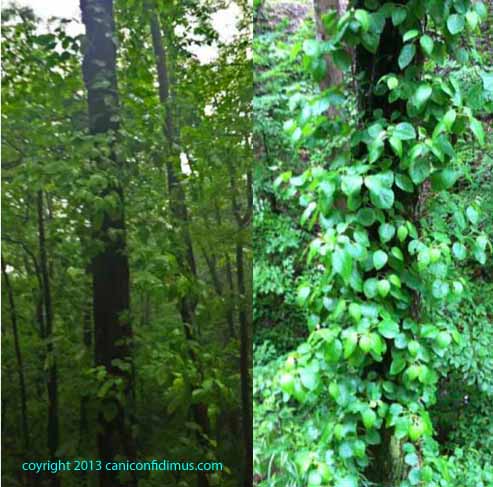
One is dangerous and the other is not
Poison ivy is on the left. This vine grew way up into an oak, with branches that extended out several feet from the trunk. These two vines don’t really look all that similar in person, but there is a good feature to look for if you get a little closer. Poison ivy vines are very hairy. Leave them alone. And especially do not put them in a fire.
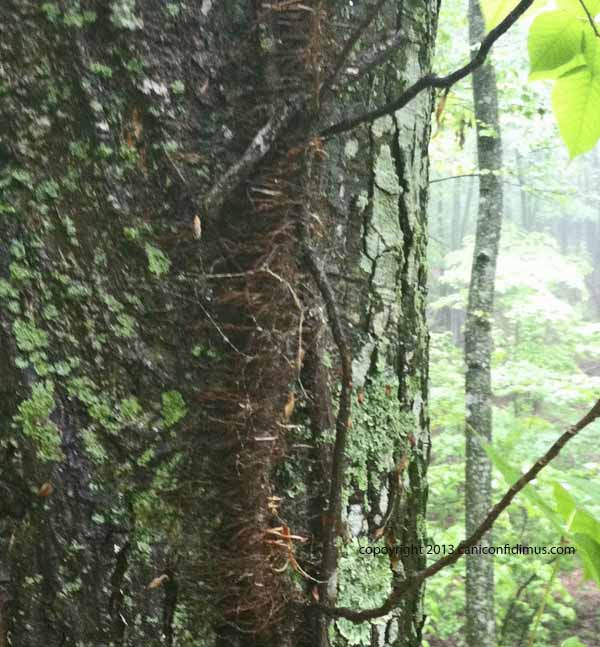
Hairy vine
When I write something like this, I like to look the subject up to learn as much as possible. In this case, it wasn’t much. I have been so attuned to poison ivy for so long that I already knew pretty much everything I found online. There are lots of Web sites that describe poison ivy and give hints about identifying it. This is one, but there are others.
I’m sure you recognized the title from the Coasters song:
“Poison ivy, poison ivy
Late at night while you’re sleeping, poison ivy comes a’ creepin’
Around”